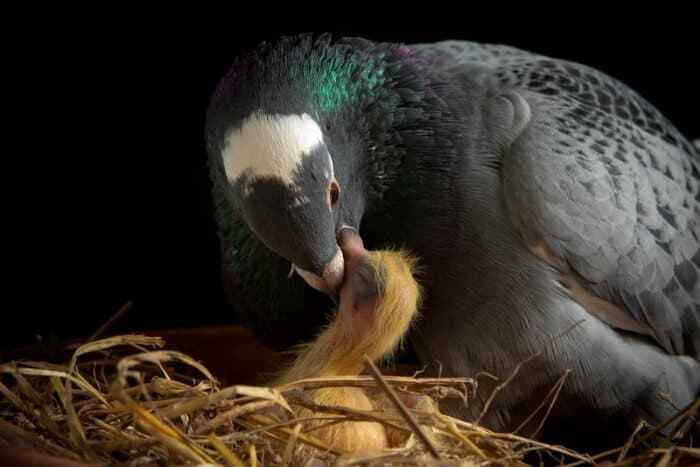Ornithosis, also known as psittacosis or chlamydiosis, is a disease that commonly affects pigeons and other species of birds across the world.
Unfortunately, it can also be passed to humans, which is why it is considered a zoonotic disease.
Read on to find out more about how pigeons get this condition, the symptoms it causes, how it is diagnosed, and how it can be treated.
What Causes Ornithosis in Pigeons?
Unlike other diseases that pigeons can develop throughout their lives, ornithosis is caused by a bacterium called Chlamydia avium.
There are several different serotypes that affect pigeons and other birds, and they tend to do so in a unique way.
For example, serotypes A and D are particularly virulent for turkeys, and as such, they cause a high mortality in this species.
By contrast, serotypes B and E are more commonly found in wild birds, including pigeons.
There are also several different species of Chlamydia, and they tend to affect different birds. Pigeons are more commonly affected by the ‘avium’ type, whereas chickens are more commonly affected by Chlamydia gallinacea.
Since chlamydiosis is a bacterial disease, it usually responds to treatment with antibiotics.
How Do Pigeons Become Infected?
Many pigeons are Chlamydia carriers even though they are completely asymptomatic.
This means that other birds can pick up the pathogen from them, whether outdoors or in their living enclosures.
However, most healthy pigeons do not develop any symptoms if they have a well-functioning immune system and if other factors aren’t present, either.
There are several different ways in which this infectious disease is transmitted — horizontally from one bird to another and vertically from the parents to the baby pigeons, for example.

Since ornithosis is a zoonotic disease, and besides humans, other mammals can pick it up from birds, too, this means that they can also be vectors for the pathogen.
Even arthropods can be carriers. However, more often than not, a pigeon will become infected while outdoors and will bring the pathogen to their environment.
There, the rest of the birds will become infected and begin showing symptoms, too, especially if their living enclosures are heavily contaminated, if the weather is cold, if their diets have been changed recently, or if they don’t have enough food or clean water.
When pigeons are transported to racing competitions, for example, they are kept close to other pigeons, so they have a higher likelihood of becoming infected with the pathogen.
The main way the bacterium is transmitted from one bird to the other is by fecal-oral route or by inhaling the pathogens from the contaminated air.
Unfortunately, some birds can be carriers but might not show any symptoms for months or even years.
Symptoms of Ornithosis in Pigeons
While ornithosis causes a number of clinical signs in sick pigeons, the pathogen mostly affects the respiratory and gastrointestinal systems.
Some of the most commonly seen symptoms are the following:
- Nose and eye discharge
- Sinusitis
- Persistent sneezing
- Conjunctivitis
- Strange droppings color (green or yellow)
- Ruffled feathers
- Weakness
- Lack of appetite
- Weight loss
In pigeons, the digestive symptoms are rarely more noticeable compared to the respiratory ones. Some birds can have an inflamed third eyelid, especially if they are young.
Their heads are swollen, they might have persistent inflammation in one eye, and they might try to alleviate their discomfort by scratching the sides of their heads.
Other birds might have severe inflammation of their eyes, some can lose their eyesight, their eyelids are completely closed, and other potentially pathogenic bacteria are involved — so the eye becomes additionally infected with pus-forming germs.
Another respiratory sign that owners can notice is breathing with a half-open beak. Some birds will actually yawn frequently, but they will do so to try to make their breathing more effective.
There are two forms that ornithosis can have in pigeons — acute and chronic.
Typically, the acute form affects young pigeons, and they tend to develop respiratory signs such as wheezing and conjunctivitis, as well as diarrhea.
The chronic form mostly affects adults whose immune system is fully developed.
Many don’t show any symptoms at all, but that does not mean that they are healthy. They could merely be asymptomatic.
Ornithosis Diagnosis
If you see any of the symptoms that we have described above in your pigeons, get in touch with your veterinarian right away.
Ornithosis is a zoonosis, so you might be putting your health in danger by not paying attention to strict hygienic measures that can prevent you from becoming infected or from becoming a carrier.
The vet will collect a number of secretions from your pigeons.
The samples from their respiratory tract and the fecal samples are usually going to be enough to perform a bacteriological exam and then an antibiogram that can reveal what antibiotic will work for treating the infection.
However, the vet also needs to perform a differential diagnosis between ornithosis and other pigeon diseases, such as infectious catarrh, Paramyxovirus, or Salmonellosis.
Some of these conditions cause similar symptoms, but they have different treatments, so your vet needs to make sure that your pigeons are indeed suffering from ornithosis and not another disease.
How To Treat It
The most common antibiotic used against chlamydiosis in pigeons is doxycycline. There are several different ways in which you can administer the medication to your pigeons.
The vet can recommend the sachet form that you can add to your pigeons’ water, but this can be a relatively unsure way of treating the disease since you have no control over how much water each pigeon drinks.
Giving the birds pills individually is usually a good way of treating them, and this is also done because some might be unable to drink enough water.
Another note we have to make with regard to the antibiotic is that pet owners should avoid giving their pigeons calcium powder supplements during the treatment period.
Unfortunately, calcium binds with doxycycline, which means that it makes the medicine less effective.
Sick pigeons should not be allowed to fly, also because they can easily spread the disease to other birds.
The minimum duration of the treatment is 25 days, although sometimes, if the infection seems to be severe and even recurring in some flocks, the vet might recommend a 50-day treatment period.
Can ornithosis in pigeons be prevented?
In many bird species, including pigeons, Chlamydiosis is endemic, which means that the likelihood of there existing many adult carriers of the pathogen is very high.
However, you can make sure that you care for your pigeons as best as possible, offer them the best food, and keep their living enclosures always clean.
When you see a bird that shows any respiratory symptoms whatsoever, isolate it from the rest and disinfect the places where the birds spend their time.
One of the worst things about this pathogen is that it can be carried on the host and can dry as a dusty substance that can be carried by wind or can remain on the walls of your pigeons’ living enclosure, for example.
For this reason, excellent hygiene is paramount, and a standard sodium hypochlorite solution and hot water are usually effective enough to kill the bacterium.
Zoonotic Risk
Humans can become infected with Chlamydia from pigeons after handling just one infected bird.
Pigeon fanciers, vets, farmers, as well as wildlife rehabilitators are the categories that are most affected by this disease.
If one of your birds is showing any symptoms, start wearing gloves and a face mask when cleaning your pigeons’ living enclosure or when handling them.
Get in touch with your veterinarian as soon as possible, and make sure that you thoroughly wash your hands before coming in contact with any other surface or person.
In people, the pathogen causes respiratory symptoms, and sometimes even pneumonia.
However, some people can suffer from a more severe form, which leads them to develop myocarditis or hepatitis — especially in immunocompromised people, like seniors, children, or those with autoimmune diseases.

This article was written by our qualified veterinarian Cristina.
This is part of our commitment to providing you with the most trustworthy veterinary advice for your pigeons.
Resources:
